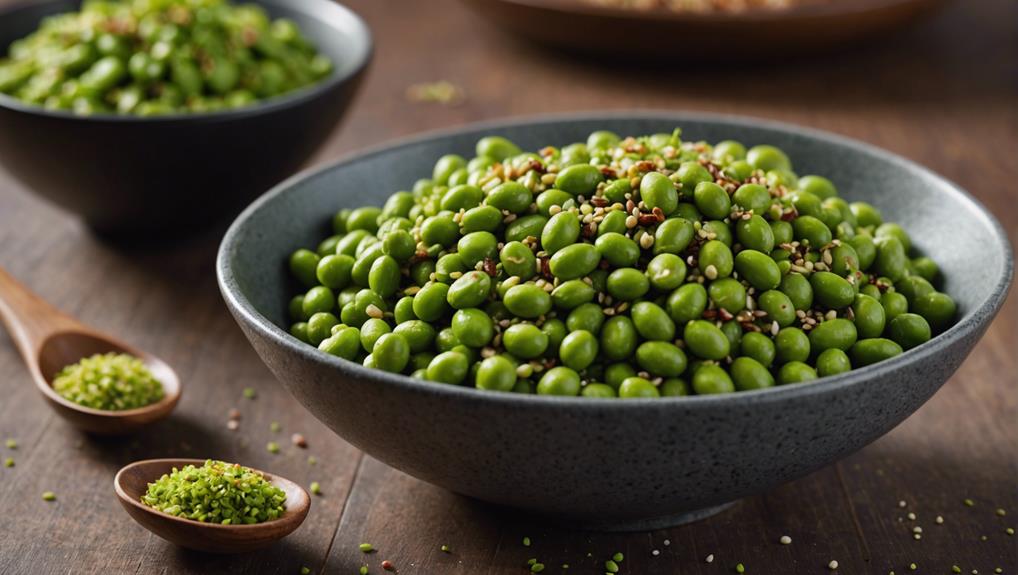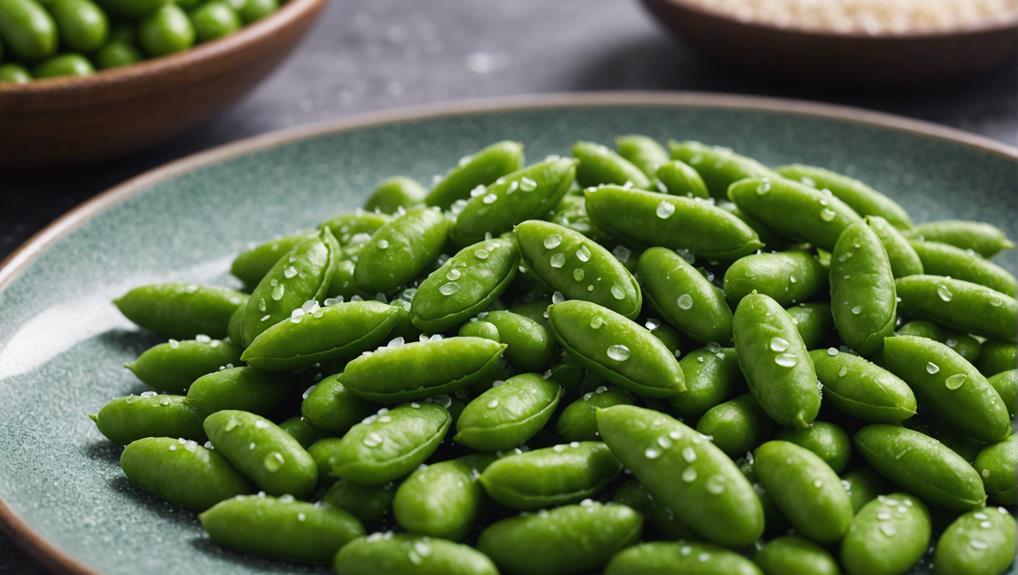Sous Vide Edamame With Sea Salt
Enhance the natural flavors of edamame by utilizing the sous vide technique with a dash of sea salt. Sous vide guarantees precise cooking, retaining nutrients and vibrant green color. The controlled temperature assures perfectly seasoned edamame. Finish with coarse sea salt for a burst of salinity and consider pairing with soy sauce for added flavor dimensions. This method preserves edamame's benefits while maximizing taste.
What You Will Learn Here
- Sous vide method ensures precise cooking for perfect edamame texture
- Retains nutrients and vibrant green color effectively
- Sea salt enhances natural flavors without overpowering
- Immersion in cold water post sous vide maintains firmness
- Ideal for elevating edamame with a gourmet touch
Edamame Origins and Evolution

Edamame, originating from China, has a rich history dating back over two millennia, evolving into a staple of Japanese cuisine during the Edo period.
The cultural significance of edamame lies in its transformation from a traditional dish to a global culinary phenomenon, celebrated for its nutritional value and versatility.
Exploring the origins and evolution of edamame sheds light on the deep-rooted traditions and widespread appeal of this beloved legume.
Origins of Edamame
The evolution of soybean cultivation in East Asia has greatly impacted the development of edamame as a popular and nutritious food source. Edamame, originating in Japan and China, is the young form of soybeans and is aptly named 'beans on branches' in Japanese due to the way they grow in clusters on the soybean plant.
This legume has been a dietary staple in East Asian countries for centuries, known for its rich nutritional profile. Packed with plant-based protein, fiber, vitamins, and minerals, edamame has garnered global recognition for its health benefits and savory taste. Its increasing popularity in Western nations aligns with the growing interest in plant-based diets and wholesome foods, solidifying its status as a sought-after ingredient.
Evolution of Edamame
Tracing the historical roots of edamame reveals a fascinating journey of soybean cultivation and culinary evolution in East Asia. Edamame, originating in China around 200 BC and later spreading to Japan, has evolved from a traditional Asian staple to a globally recognized food. Its easy-to-make nature has contributed to its widespread popularity.
In the late 20th century, edamame gained traction in the United States due to its nutritional benefits and adaptability in various cuisines. The rich protein content, fiber, vitamins, and minerals make edamame a healthy snack choice. The evolution of edamame showcases its adaptability and appeal across diverse cultures, highlighting its journey from a regional delicacy to a beloved global ingredient.
Cultural Significance of Edamame
Originating in ancient East Asia, the cultivation and culinary journey of edamame reveal its deep cultural significance and evolution over centuries. Edamame, originating in China and Japan, has been cherished for its nutritional value and taste. The term 'edamame' specifically refers to young soybeans still in the pod, harvested before full maturity. This soybean variety is packed with protein, fiber, vitamins, and minerals, making it a favorite among vegetarians and vegans. Its popularity in Western countries as a healthy snack or cooking ingredient highlights its cultural adaptability. In Japanese cuisine, edamame is often served as an appetizer or side dish, showcasing its versatility and esteemed place in culinary traditions.
| Edamame Origins | Edamame Evolution | Cultural Significance |
|---|---|---|
| China and Japan | Nutrient-rich | Versatile and revered |
Edamame Seasoning Varieties

When choosing seasonings for edamame, consider options like sea salt, garlic salt, truffle salt, chili flakes, or furikake to enhance the soybean's flavor profile. Each of these seasonings offers a unique taste experience that can elevate the natural flavors of edamame.
Sea salt, a classic choice, brings out the soybean's inherent nuttiness, while garlic salt adds a savory punch to each bite. Truffle salt lends a luxurious earthiness, perfect for those looking to indulge in a more refined flavor profile.
If you prefer a bit of heat, chili flakes can provide a spicy kick to your edamame, adding excitement to each mouthful. For a taste of umami, try furikake, a Japanese seasoning blend that combines seaweed, sesame seeds, and dried fish flakes for a truly distinctive flavor experience.
Experimenting with these seasoning varieties can transform your edamame into a delightful culinary adventure.
Edamame Sesame Oil Recipe
When considering the POINTS for your Edamame Sesame Oil Recipe, you'll find variations such as Sea Salt Edamame Boil, Soy Sauce Edamame Recipe, and Spicy Edamame Garlic Recipe. These options offer diverse flavor profiles that can enhance your edamame experience.
Experimenting with different seasoning varieties can elevate the taste and appeal of your sous vide edamame dish.
Sea Salt Edamame Boil
For the essential enhancement of edamame's flavor profile and texture, consider incorporating sea salt in the sous vide cooking process. Sea salt plays a vital role in elevating the natural taste of edamame, making it a delightful snack or side dish option.
Here are three key points to keep in mind when preparing sea salt edamame sous vide:
- Enhanced Flavor: Sea salt amplifies the inherent flavors of edamame, providing a savory and satisfying taste experience.
- Balanced Seasoning: Properly seasoning edamame with sea salt during sous vide cooking ensures a harmonious balance of flavors without overpowering the natural taste of the beans.
- Nutrient Retention: Sous vide cooking with sea salt helps edamame retain its nutritional value, making it a healthy and delicious choice for any meal.
Soy Sauce Edamame Recipe
To explore a different culinary dimension for edamame, consider infusing the beans with soy sauce and sesame oil in this innovative recipe.
- Flavorful Twist: The easy-to-follow soy sauce edamame recipe brings a delightful umami taste to these nutritious beans.
- Nutrient Preservation: By using sous vide cooking, you guarantee that the edamame beans retain their essential nutrients.
- Aromatic Element: Sesame oil adds a nutty aroma that complements the natural flavors of the edamame, making this dish a flavorful and easy snack option.
Try this soy sauce edamame recipe for a quick, tasty, and healthy snack that's sure to satisfy your taste buds with minimal effort.
Spicy Edamame Garlic Recipe
Infusing edamame with garlic and drizzling it with sesame oil enhances the flavor profile of this spicy sous vide recipe, creating a delicious and nutritious snack option.
When preparing a salted edamame recipe with a spicy twist, consider the following:
- Garlic Infusion: Garlic adds a layer of complexity to the edamame, introducing a subtle spiciness and aromatic notes that elevate the dish.
- Sesame Oil Drizzle: Drizzling sesame oil over the edamame not only imparts a nutty flavor but also enhances the overall richness of the beans, creating a harmonious blend of tastes.
- Nutrient-Rich Snack: This salted edamame recipe offers a healthy snacking alternative packed with essential nutrients, making it a satisfying option for any time of day.
Edamame Blanching Technique
When blanching edamame, you aim to maintain its bright green hue while ensuring a crisp texture. This technique involves quickly cooking the pods to enhance their overall quality.
Blanching is essential for softening the pods, making it easier to extract the beans.
Blanching Edamame Quickly
For best results, blanch frozen edamame quickly by boiling the beans for about 5 minutes until they turn a bright green color and reach a tender texture. This rapid blanching process is essential to cook the edamame while preserving its natural qualities, including vibrant color and crisp texture.
Quick blanching prevents overcooking, ensuring the edamame maintains its flavors. Once blanched, drain the edamame and season with sea salt for a simple and delicious snack.
Maintaining Bright Green
To maintain the bright green color of blanched edamame, promptly submerge the beans in cold water after boiling. This essential cooling process halts the cooking and sets the color, preserving the vibrant green hue of the edamame beans.
The blanching step, lasting about 5 minutes in boiling water, is vital for maintaining the appealing appearance of the edamame. By immediately transferring the blanched beans into cold water, you guarantee that the color remains vivid and fresh.
Bright green edamame not only pleases the eye but also signifies the beans' freshness and proper blanching technique. Remember, the key to keeping your edamame looking vibrant is the quick blanching followed by a cold water bath.
Retaining Crisp Texture
Blanching edamame in cold water post-cooking is vital for preserving their crisp texture. This rapid cold shock halts the cooking process, locking in the desired crunchiness of the beans. By swiftly immersing the edamame in cold water, you maintain their firmness and prevent them from becoming mushy.
This simple yet essential step guarantees that your edamame remains tender while retaining a satisfying bite. When preparing your salted edamame dish, the blanching technique ensures an excellent mouthfeel, enhancing the overall eating experience.
To elevate the flavor profile further, consider finishing off with a sprinkle of coarse sea salt, which not only adds a burst of salinity but also complements the crisp texture of the edamame.
Final Thoughts
In conclusion, the sous vide method offers a precise and efficient way to prepare flavorful and nutrient-rich edamame with sea salt. By vacuum-sealing the edamame and cooking it in a water bath at a controlled temperature, you guarantee even cooking and the retention of essential nutrients and flavors. The result is perfectly seasoned edamame with a tender texture that maintains its vibrant green color. This method not only provides convenience but also yields a healthy snack that's hands-off and hassle-free to prepare.
When serving your sous vide edamame with sea salt, consider enhancing the experience further by offering a side of soy sauce for dipping. The umami-rich soy sauce can complement the natural sweetness of the edamame and add a depth of flavor to each bite. This simple addition can elevate your edamame snack to a new level of taste sensation, making it a delightful treat for yourself or to share with others.
Frequently Asked Questions
Is Edamame With Salt Good for You?
Edamame with salt can be good for you in moderation. It provides essential minerals and nutrients but watch your salt intake. Enjoying this snack can be a part of a balanced diet for added nutrition.
Do You Have to Cook Frozen Shelled Edamame Before Eating?
You should always cook frozen shelled edamame before eating to guarantee safety. Cooking enhances the flavor, texture, and digestibility of edamame. Properly cooking eliminates harmful bacteria. Enjoy the benefits of edamame by cooking it first.
Is It Better to Steam or Boil Edamame?
When it comes to edamame, steaming preserves more nutrients and keeps the natural flavors intact compared to boiling. Steaming results in a vibrant color and firmer texture, making it the preferred method for better taste.
How Do You Eat Salted Edamame?
To eat salted edamame, first, remove the beans from the pod. Then, simply enjoy the delicious and nutritious snack. The sea salt enhances the soybean nutrition, providing a flavorful and satisfying experience that is both healthy and tasty.
Conclusion
To sum up, sous vide edamame with sea salt provides a unique and flavorful way to enjoy this nutritious legume.
The precise temperature control of the sous vide method guarantees that the edamame is cooked perfectly, while the addition of sea salt enhances its natural flavors.
By following the simple instructions outlined in this article, you can easily create a delicious and satisfying snack or side dish that will impress your taste buds.











